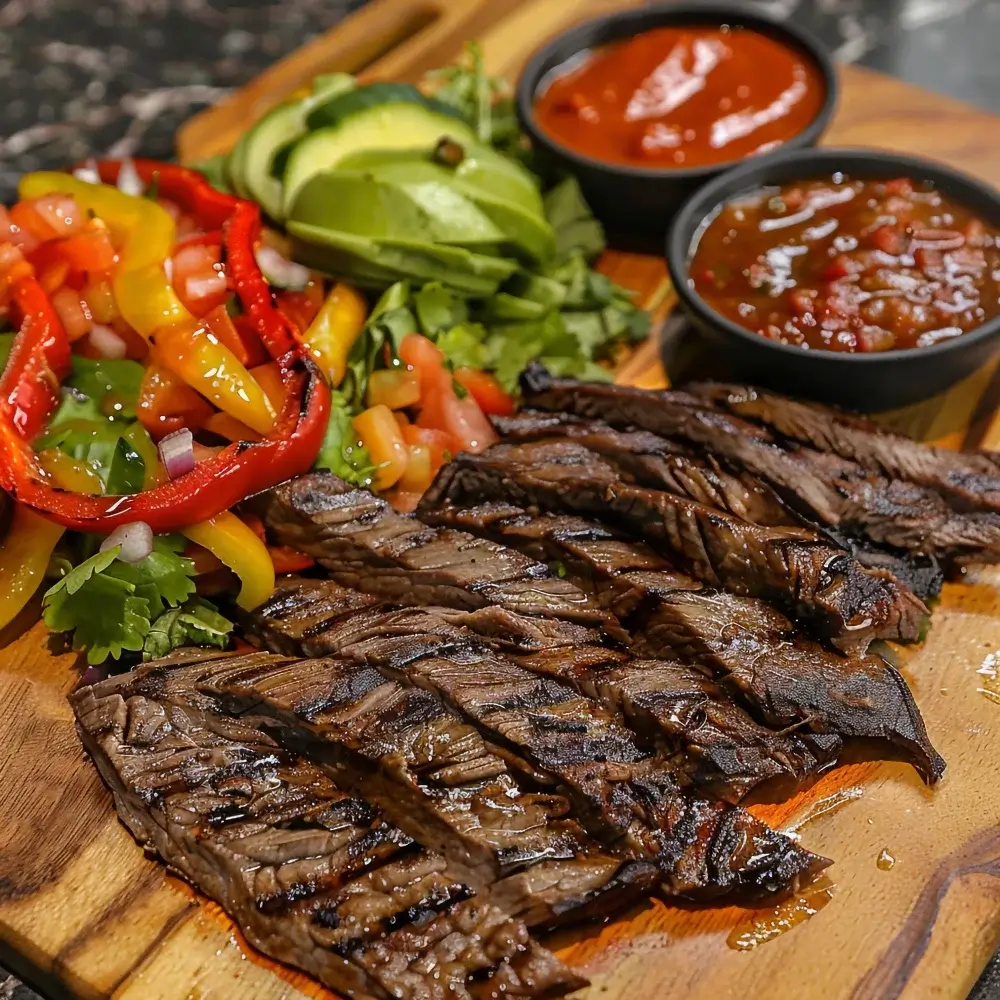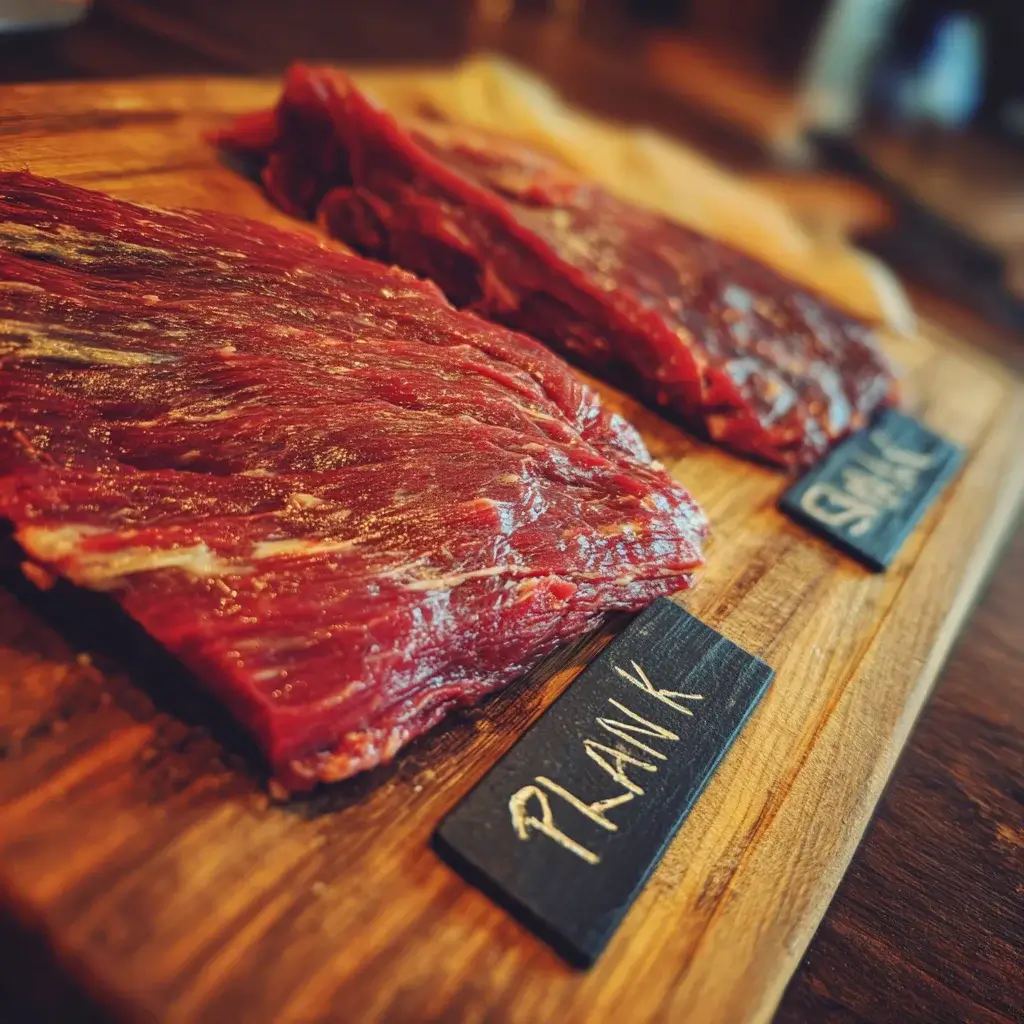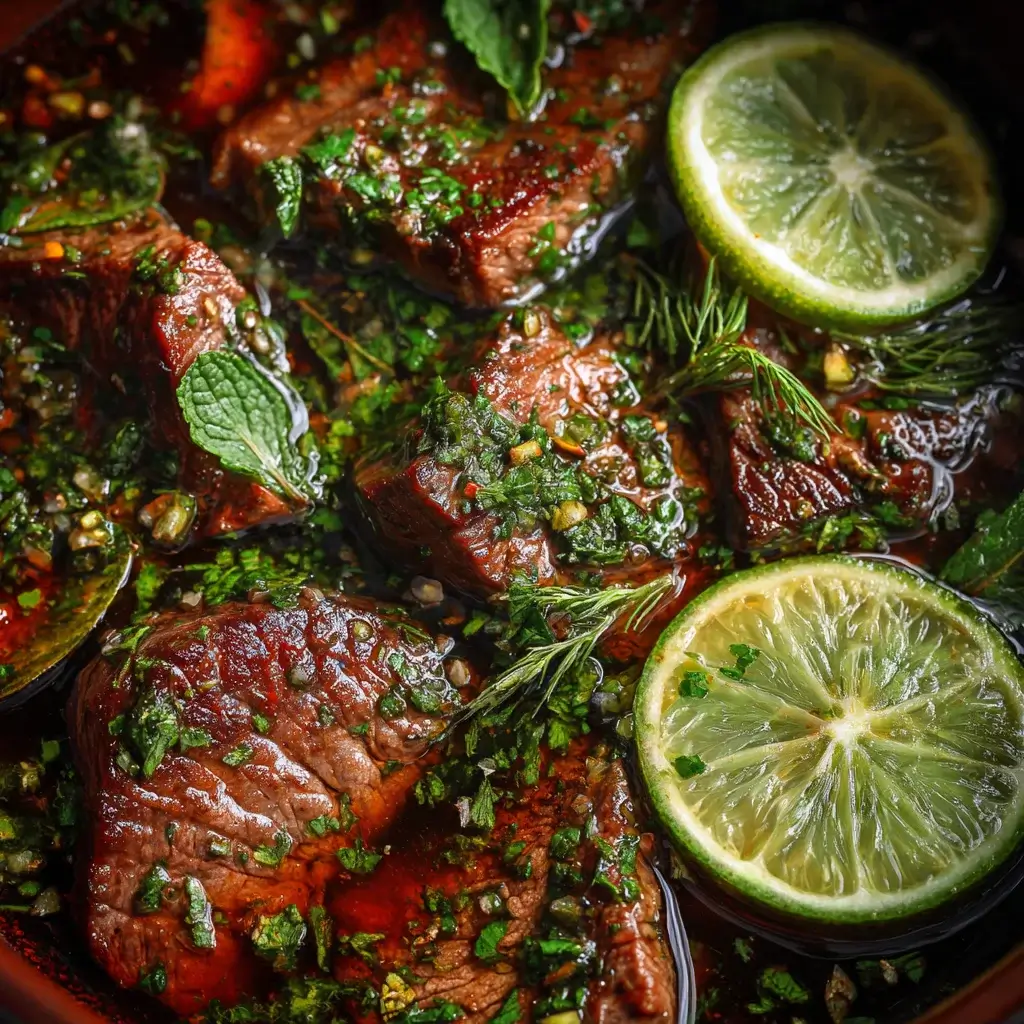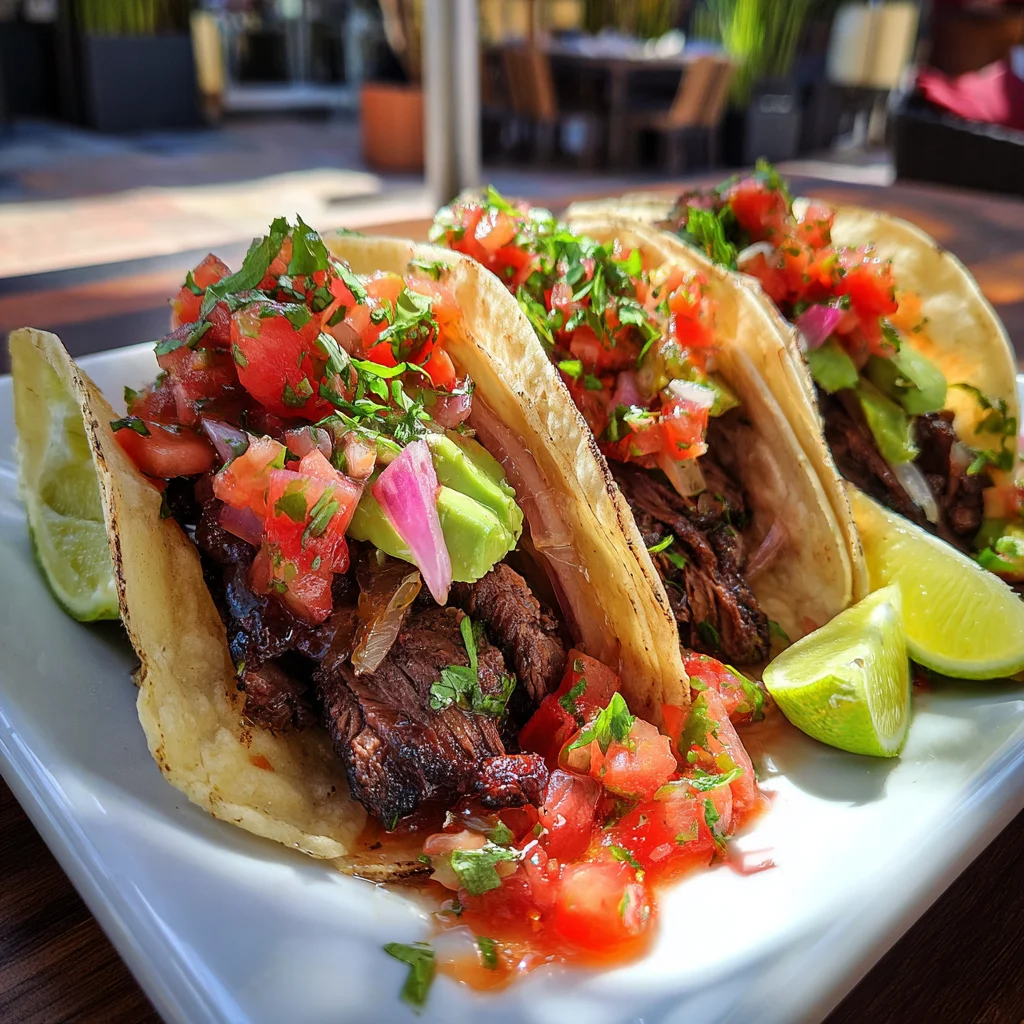
Carne asada—grilled beef with smoky char, bold spices, and a burst of citrus—is more than just a dish; it’s a cultural staple found in kitchens across Mexico and Latin America. From lively backyard BBQs in California to the vibrant street vendors in Guadalajara, carne has earned its place as a favorite among meat lovers, delivering juicy, flavorful bites with every piece.
Table of Contents
Table of Contents
Join Amelia Chef as she guides you through the art of creating the perfect carne asada. In this ultimate guide, we’ll show you how to choose the best cuts of meat, craft a tantalizing marinade, and avoid common grilling mistakes. We’ll also explore the regional variations of carne throughout Latin America and dive into its nutritional breakdown. Curious about how Mexicans enjoy their carne asada or which cuts of meat are best? We’ve got all the answers in the FAQs section. Prepare to become a carne asada pro with this deliciously informative guide!
What Is Carne Asada?
What does “carne asada” really mean?
At its core, carne asada means “grilled meat” in Spanish—carne meaning meat and asada referring to roasting or grilling. But this simple translation doesn’t capture the depth of flavor and tradition behind the dish.
Carne asada refers specifically to thin slices of beef, usually marinated in citrus juice, garlic, and spices, then grilled over high heat until charred and tender. It’s often served sliced thin, tucked into tacos, or paired with rice, beans, and salsa.
In many households and taquerías, carne asada is a weekend event—a reason to fire up the grill, gather the family, and enjoy a casual feast. In the U.S., it’s become a menu favorite in Mexican restaurants and food trucks, often starring as the protein in street tacos or burrito bowls.
The cultural roots of Mexican-style grilled beef
Carne asada isn’t just food—it’s a tradition that unites people. In Northern Mexico, it’s common to host a carne gathering, similar to an American barbecue. It’s not just about the food but about community, storytelling, and celebration.
The technique and spices can trace their roots back to Spanish colonial times, when grilling over open flames became a way to infuse meat with robust flavor using simple ingredients. As the practice spread across Latin America, every region added its own twist—from the spicy rubs of Sonora to the citrusy marinades of Baja California.
Choosing the Best Cut for Carne Asada
Flank vs. Skirt Steak: Which One Is Ideal?
When it comes to making authentic carne asada, the cut of beef you choose will define everything—from texture to flavor. The two most commonly used cuts are flank steak and skirt steak. So, which is better?

Skirt steak is often considered the gold standard for traditional carne asada. It’s thin, naturally flavorful, and loaded with marbling that melts beautifully on a hot grill. It cooks quickly and absorbs marinades very well.
Flank steak, on the other hand, is leaner and a bit thicker. It’s still packed with beefy flavor, but it needs proper marination to stay tender. When sliced correctly, it makes for excellent carne asada tacos and burritos.
| Cut of Beef | Texture | Flavor Intensity | Best For |
|---|---|---|---|
| Skirt Steak | Tender, loose grain | Strong, beefy | Authentic tacos, fast grilling |
| Flank Steak | Lean, tight grain | Mild, clean | Bowls, slicing for burritos |
Why Beef Texture and Grain Direction Matter
Here’s a common mistake: slicing the meat the wrong way. No matter which cut you use for your carne asada recipe, the way you slice the steak is key to tenderness.
Both flank and skirt steak have visible muscle fibers, or “grain.” If you cut with the grain, the meat will be chewy. But when you cut against the grain, you shorten those fibers, making the steak tender and easier to chew.
For perfect results:
- Let the grilled steak rest for 5 minutes before slicing.
- Use a sharp knife to slice it thinly, against the grain, at a slight angle.
The Perfect Carne Asada Marinade
Key Marinade Ingredients for Bold Flavor
No great carne asada is complete without a flavorful marinade that brings out the rich, smoky essence of grilled beef. A classic carne marinade blends citrus, spice, and aromatics that tenderize the meat while packing it with flavor.

Here’s a breakdown of the core ingredients you should include in any carne asada recipe:
| Ingredient | Purpose |
|---|---|
| Lime juice | Tenderizes meat, adds zest |
| Orange juice | Slight sweetness + acidity |
| Garlic | Deepens umami flavor |
| Cilantro | Adds freshness |
| Jalapeño/Chili | Heat and depth |
| Cumin & Paprika | Warm, earthy spice foundation |
| Olive oil | Helps distribute flavors evenly |
| Salt & Pepper | Enhances overall taste |
Marinate your steak for at least 2 hours, but for best results, let it sit overnight in the fridge. The citrus will break down the fibers of the meat, making it tender and allowing the spices to seep deep into the steak.
How Long Should You Marinate Carne Asada?
This is one of the most frequently asked questions—and for good reason. The marinade time affects both texture and flavor.
- Minimum time: 2 hours
- Recommended time: 6–8 hours
- Maximum: 24 hours (especially for tougher cuts like flank steak)
Marinating your carne asada too long—especially beyond 24 hours—can turn the outer layer of the meat mushy due to overexposure to acidic ingredients.
Quick Tip: If you’re short on time, a vacuum-sealed marinade bag can help infuse flavor faster. Still, nothing beats the slow soak of an overnight marinade for that authentic Mexican carne asada taste.
How to Cook Carne Asada Like a Pro
Grilling Tips for Juicy and Charred Results
You’ve got your beef. You’ve nailed the marinade. Now, it’s time to cook that asada to smoky, sizzling perfection. Grilling is the traditional and most flavorful method to prepare carne asada, and getting it right requires attention to heat, timing, and a few chef-approved techniques.
Here’s how to grill carne asada like a pro:
- Preheat the grill: Make sure your grill is very hot before adding the meat. You want a quick sear that locks in moisture.
- Oil the grates: Lightly brush the grill grates with oil to prevent sticking.
- Cook fast and hot: Carne asada should be grilled over high heat—about 450–500°F—for just 3 to 5 minutes per side depending on the cut’s thickness.
- Flip once: Let the beef develop that perfect char before turning it. One good flip is all you need.
- Rest before slicing: After grilling, let your carne asada steak rest for about 5 minutes. This allows juices to redistribute and keeps the meat tender.
Pan-Searing vs. Grilling: When and Why?
What if you don’t have a grill? Can you still make mouthwatering carne asada indoors? Absolutely.
Pan-searing is a great alternative when outdoor grilling isn’t an option. Use a cast-iron skillet over high heat and follow these steps:
- Heat the skillet until it’s smoking hot.
- Add a little oil and sear each side for 2–3 minutes.
- Reduce heat slightly to finish cooking (if the cut is thick).
- Let the steak rest before slicing, just as you would after grilling.
How to Serve Carne Asada
Traditional Side Dishes and Sauces
Once your carne asada is grilled to perfection, it’s time to plate it up! One of the best parts about carne is how versatile and satisfying it is. Whether you’re throwing a backyard fiesta or preparing a casual dinner, serving it with the right sides enhances the whole experience.

Here are some traditional sides that complement the rich, smoky flavor of carne asada:
- Mexican rice – Fluffy, tomato-infused rice to soak up the juices
- Refried or black beans – Creamy and earthy with a hint of spice
- Pico de gallo – A refreshing contrast made with chopped tomatoes, onions, and cilantro
- Guacamole – Creamy, tangy, and loaded with lime
- Grilled onions and peppers – Adds a sweet and smoky kick
Optional additions: Warm flour or corn tortillas, lime wedges, and pickled jalapeños for an extra boost of brightness and heat.
Transforming Carne Asada into Tacos, Burritos, and Bowls
While carne asada can stand tall on its own, it becomes even more irresistible when folded into tacos, wrapped in burritos, or layered in bowls. The meat’s smoky char, enhanced by marinade spices, makes it the perfect protein base.
Carne Asada Tacos:
- Slice the steak thinly against the grain
- Add to a corn tortilla
- Top with chopped onions, cilantro, and a squeeze of lime
Carne Asada Burritos:
- Use a large flour tortilla
- Fill with rice, beans, grilled carne asada, sour cream, cheese, and avocado
- Roll it tight and toast the outside for a crispy bite
Carne Asada Bowls:
- Build with a rice base
- Add steak, beans, grilled veggies, salsa, and a drizzle of crema
- Perfect for meal prep or weeknight dinners
With these simple serving ideas, your carne asada can be customized for any occasion—from casual family meals to party platters. It’s all about layering bold flavors and textures to elevate the dish.
Carne Asada Around Latin America
Regional Variations in Seasoning and Preparation
While most people associate carne asada with Mexican cuisine, this beloved grilled meat has roots and variations that span across Latin America. Each country adds its own spin—from seasoning styles to cooking techniques—making carne a truly diverse dish.
In Northern Mexico, especially states like Sonora and Nuevo León, carne asada is grilled over mesquite wood, giving it a distinctly smoky flavor. The seasoning here is often simpler—just salt, lime, and maybe a bit of garlic—allowing the quality of the beef to shine.
In Southern Mexico, citrus-heavy marinades are more common, along with additional spices like achiote and oregano. These blends often create a more tangy and herbaceous profile.
In Guatemala, carne asada might include soy sauce and Worcestershire in the marinade, reflecting the country’s fusion of local and foreign culinary influences. You’ll often find it served with grilled plantains or spicy cabbage slaw.
Argentina and Uruguay may not use the term “carne asada” in the same way, but their famous asado tradition mirrors it closely—grilling various cuts of beef over wood or charcoal with minimal seasoning. Here, chimichurri sauce—a blend of parsley, garlic, vinegar, and oil—takes center stage as the go-to topping.
What Mexicans Call Carne Asada vs. Other Countries
In Mexico, carne asada isn’t just a dish—it’s an event. Locals use the phrase to describe both the grilled meat and the gathering itself. Saying “vamos a hacer carne asada” (we’re going to make carne asada) usually means a backyard BBQ with friends and family, cold drinks, and a spread of tortillas, salsas, and sides.
In countries like Honduras and El Salvador, you may hear similar grilled meats called “asado de res” or simply “asado.” Though not always marinated in the same citrusy fashion, the technique—grilling thin cuts of beef over high heat—remains consistent.
Carne Asada at Home vs. Street Food
How Street Vendors Make It Irresistible
If you’ve ever strolled through the streets of Mexico or Latin neighborhoods in the U.S., you’ve likely caught the unmistakable smell of sizzling carne asada on a hot grill. Street vendors have mastered the art of making this dish crave-worthy, often with just a few tools and time-tested tricks.
Here’s what makes street-style carne asada different:
- High-heat grilling on flat-top grills or open flames
- Paper-thin cuts of beef for quick cooking and easy taco assembly
- Simple marinades that highlight the meat, often just lime, salt, and garlic
- Quick chopping right off the grill so every bite is juicy and fresh
- Assembly-line efficiency to serve dozens of people fast
Most street vendors use beef skirt steak or thin flank because it grills fast and carries bold flavor well. Once cooked, the meat is often chopped into small bits, piled into corn tortillas, and topped with onions, cilantro, and salsa roja or verde.
DIY Carne Asada: Home Cook Hacks That Work
Making carne asada at home can be just as satisfying—even if you don’t have a big outdoor grill or commercial flat-top. With the right methods, you can bring that street-food magic to your kitchen or backyard.
Here are a few pro hacks for killer home-cooked:
- Use a cast-iron pan if you’re cooking indoors. Get it extremely hot for a charred sear.
- Marinate overnight to replicate the depth of flavor street vendors achieve.
- Cut thin and across the grain for maximum tenderness.
- Warm your tortillas properly—on a dry pan or directly over a flame.
- Serve fast. Carne asada tastes best right off the heat, so prep all your toppings ahead of time.
For larger groups, use a propane griddle or plancha. It mimics the setup many taco stands use and allows you to grill multiple steaks at once.
Common Mistakes to Avoid
Marinating Mishaps and Overcooking
Even seasoned home cooks can slip up when preparing carne asada. One of the most common mistakes? Misunderstanding how long to marinate the meat. While marination is key to flavor and tenderness, too much time can actually ruin the texture of your steak.
Avoid these marinating mistakes:
- Over-marinating: Leaving the meat in citrus-heavy marinades for more than 24 hours can break down the muscle fibers too much, resulting in a mushy texture.
- Under-marinating: Less than an hour won’t give the meat time to absorb the bold flavors essential to great carne.
- Uneven coverage: Always make sure the meat is completely coated. Use a resealable bag or covered container to keep things airtight.
Another issue? Overcooking. Thin cuts like skirt or flank steak can go from juicy to dry in a flash.
Tips to prevent overcooking your carne asada:
- Grill over high heat and flip only once.
- Use a meat thermometer: Pull the steak at 130°F for medium-rare.
- Let it rest before slicing—this locks in juices.
- Don’t walk away! These cuts cook quickly and require attention.
Remember, you want char on the outside, but a juicy, pink center inside. That’s what makes carne so satisfying.
Cutting Against the Grain: Why It Matters
One of the most underrated tricks to tender carne asada is how you slice it. After grilling, if you cut the steak with the grain (in the same direction the muscle fibers run), your meat will end up chewy and tough.
Here’s how to do it right:
- Identify the grain (the visible lines running across the meat).
- Slice perpendicular to those lines.
- Cut thin slices, on a slight diagonal, for the best bite.
Cutting against the grain shortens the muscle fibers, making each piece easier to chew and enjoy. It’s a small step that makes a huge difference in texture and tenderness.
Nutrition & Health Aspects
Protein, Fat, and Calorie Breakdown
If you’re wondering whether carne asada is healthy, the answer depends on your cut of meat, preparation method, and what you serve it with. At its core, carne is simply grilled beef, which offers a great source of protein, iron, zinc, and B vitamins.
Here’s a breakdown of the nutrition in a typical 3-ounce serving of grilled flank steak:
| Nutrient | Amount (3 oz) |
|---|---|
| Calories | 180–220 |
| Protein | 22–25 grams |
| Fat | 9–12 grams |
| Saturated Fat | 3–4 grams |
| Iron | 15% of Daily Value |
Skirt steak tends to be a bit higher in fat than flank steak, so if you’re looking to keep it lean, flank is your best bet. Also, the use of olive oil and citrus in the carne marinade provides healthy fats and antioxidants.
Is Carne Asada Healthy? A Balanced Look
In moderation, carne asada can be a smart addition to a balanced diet—especially when paired with nutritious sides like beans, grilled vegetables, and avocado. The lean beef delivers essential nutrients and keeps you feeling full thanks to its high protein content.
To make your carne asada even healthier:
- Trim visible fat from the steak before cooking
- Use a low-sodium marinade
- Grill instead of frying
- Serve with whole-food sides like black beans, corn, or quinoa
What you avoid is just as important as what you add. Skip the heavy cheese toppings, sour cream overloads, and deep-fried tortillas if you’re watching calories or sodium.
And don’t forget—portion control plays a role too. A 3- to 4-ounce serving of carne asada steak is plenty to satisfy without going overboard.
Bottom line: Carne asada isn’t just delicious—it’s also a solid protein option when prepared with fresh, whole ingredients and mindful portions.
Let’s stay connected! Follow me on Pinterest and YouTube for more delicious sweet and savory recipes. Have a question? Ask in the comments or contact us, and I’ll be happy to help! 🤗 With love, Amelia!
Carne asada isn’t just a dish—it’s a tradition, a celebration, and a symbol of shared meals. Whether you’re grilling in your backyard or recreating the vibrant flavors of a taco stand, the key to perfect carne lies in choosing the right cut, building a bold marinade, and cooking with care.
Now that you know how to avoid common mistakes, prepare healthy sides, and embrace the cultural richness of this Latin American favorite, you’re ready to grill like a pro. Use these tips and make carne asada the centerpiece of your next unforgettable meal.
Frequently Asked Questions
1. What type of meat is carne asada?
Carne asada is typically made from flank steak or skirt steak, both known for their bold, beefy flavor and ability to absorb marinades well. These cuts are thin, cook quickly over high heat, and slice easily against the grain for tender bites. In some regions, chuck steak or sirloin is used, but flank and skirt remain the most traditional options for authentic carne.
2. How do you pronounce asada?
“Asada” is pronounced ah-SAH-dah. The emphasis is on the middle syllable: sa. It’s a Spanish word meaning “grilled” or “roasted,” most commonly used in reference to meat. So when you say carne asada, you’re saying “grilled meat.”
3. What do Mexicans call carne asada?
In Mexico, “carne asada” refers to both the dish and the social event where it’s served. It’s a cultural gathering, much like an American BBQ. People will say, “Vamos a hacer carne asada,” which means, “Let’s have a cookout.” In some regions, the meat is also simply called “asada,” especially in taco stands and street markets.
4. How long should I marinate carne asada?
Ideally, carne asada should be marinated for 6 to 8 hours to absorb maximum flavor. However, if you’re short on time, marinating for at least 2 hours can still yield great results. Avoid going beyond 24 hours, as the acidic ingredients in the marinade (like lime or orange juice) can start breaking down the meat too much, making it mushy.
